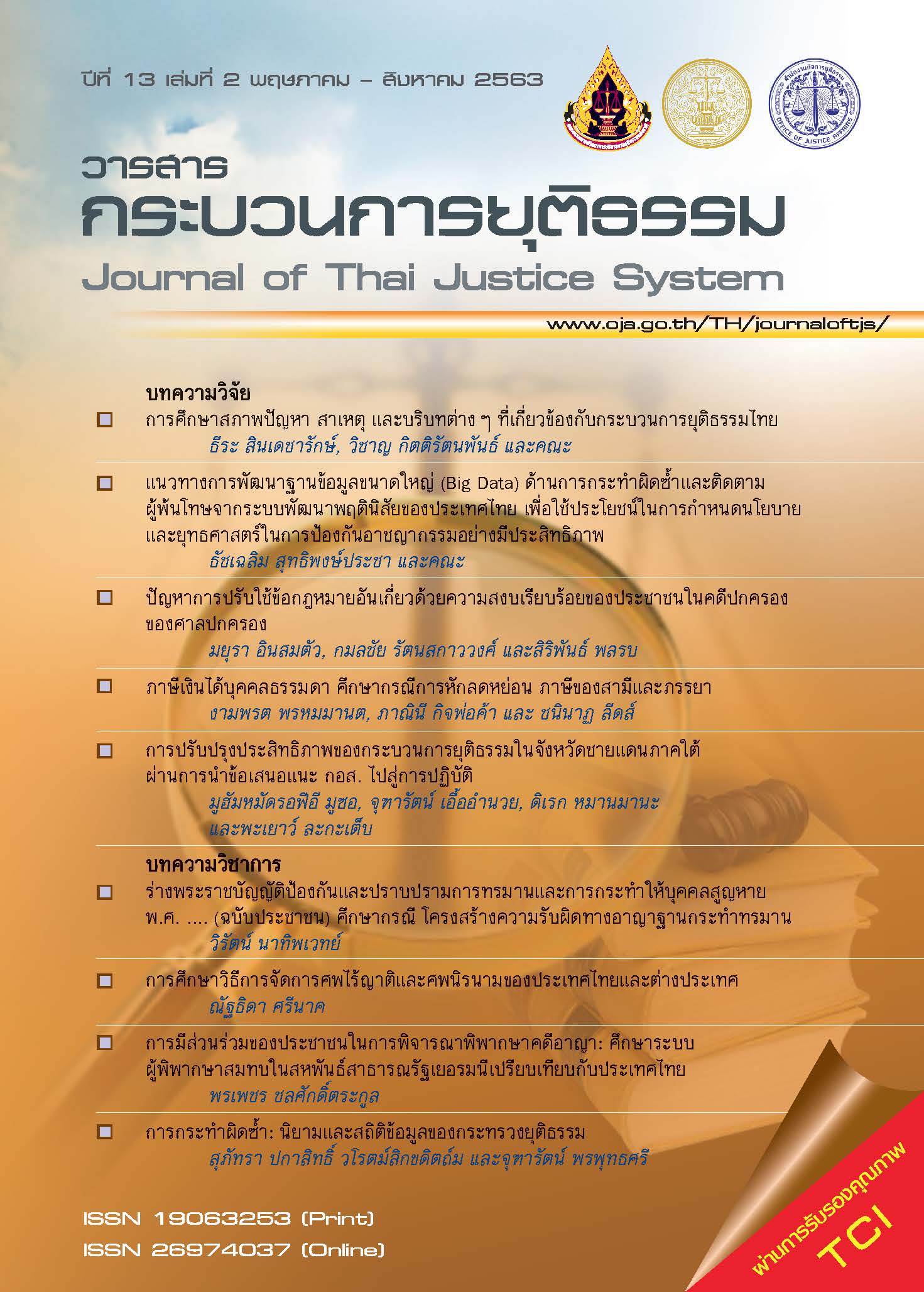การศึกษาสภาพปัญหา สาเหตุ และบริบทต่าง ๆ ที่เกี่ยวข้องกับกระบวนการยุติธรรมไทย
Main Article Content
บทคัดย่อ
โครงการวิจัยนี้มีวัตถุประสงค์ 3 ข้อ ได้แก่ (1) เพื่อนำข้อมูลที่ได้จากการทดลองจัดเก็บข้อมูลตามตัวชี้วัดประสิทธิภาพกระบวนการยุติธรรมทางอาญามาใช้ในการวิเคราะห์และประเมินจุดอ่อน/จุดแข็ง/โอกาส และความท้าทายของกระบวนการยุติธรรมไทยในมิติต่าง ๆ ตามกรอบตัวชี้วัดประสิทธิภาพกระบวนการยุติธรรมทางอาญาในด้านที่สามารถดำเนินการได้ก่อนเนื่องจากนิยามที่ชัดเจนแล้ว (2) เพื่อเสนอแนวทางในการแก้ไขปัญหาในรูปแบบของข้อเสนอแนะเชิงนโยบายและการกำหนดเป้าหมายในการพัฒนาประสิทธิภาพกระบวนการยุติธรรมในอนาคตอย่างเป็นรูปธรรม และ (3) เพื่อพัฒนารูปแบบ และแนวทางในการนำตัวชี้วัดประสิทธิภาพกระบวนการยุติธรรมทางอาญามาใช้กำหนดทิศทางการพัฒนากระบวนการยุติธรรมไทย โดยเชื่อมโยงกับการพัฒนาแผนบูรณาการ และแผนยุทธศาสตร์ระดับชาติด้านกระบวนการยุติธรรม รวมทั้งแผนแม่บทการพัฒนาการบริหารงานยุติธรรมแห่งชาติในระยะต่อไป
ผลการศึกษา พบว่า
- จากการทดลองจัดเก็บข้อมูลตามตัวชี้วัดประสิทธิภาพกระบวนการยุติธรรมทางอาญาที่ได้ข้อมูลมาจากการขอความอนุเคราะห์หน่วยงานในกระบวนการยุติธรรมอาญาที่เกี่ยวข้องใน 7กรอบ รวม 21 ตัวชี้วัด พบว่า สามารถจัดเก็บข้อมูลได้ (เบื้องต้น) มา 17 ตัวชี้วัด ยังไม่สามารถจัดเก็บได้อีก 4 ตัวชี้วัด เมื่อเปรียบเทียบกับปีก่อนหน้านี้สามารถจัดเก็บข้อมูลได้เพิ่มขึ้น 4 ตัวชี้วัด ในตัวชี้วัดที่จัดเก็บได้มีผลการดำเนินการที่ดีขึ้น 8 ตัวชี้วัด แย่ลง 5 ตัวชี้วัด อีก 7 ตัวชี้วัด ที่เหลือยังไม่สามารถเปรียบเทียบได้เนื่องจากบางตัวยังจัดเก็บข้อมูลไม่ได้บางตัวเพิ่งจัดเก็บได้เป็นปีแรก
- เสนอแนวทางในการแก้ไขและกำหนดเป้าหมายในการพัฒนาประสิทธิภาพกระบวนการยุติธรรมในอนาคต คือการนำระบบเทคโนโลยีดิจิทัล (digital technology system) มาใช้ในการดำเนินการในขั้นตอนต่าง ๆ ของกระบวนการยุติธรรมตั้งแต่ขั้นตอนการสอบสวน (พนักงานสอบสวน) ขั้นตอนการสั่งคดี (พนักงานอัยการ) ขั้นตอนการพิจารณาพิพากษาคดี (ศาล) จนถึงขั้นตอนการบังคับโทษ (กรมราชทัณฑ์) และหน่วยงานอื่น ๆ โดยเป็นการใช้ระบบเดียวกัน ซึ่งนอกจากจะทำให้กระบวนการยุติธรรมเป็นไปด้วยความรวดเร็ว โปร่งใสและตรวจสอบได้แล้ว ยังเป็นการบูรณาการข้อมูลได้อย่างมีประสิทธิภาพอีกด้วย
- การใช้เทคโนโลยีสารสนเทศและเทคโนโลยีดิจิทัลในกระบวนการยุติธรรมทางอาญาและการบังคับใช้กฎหมายเป็นไปตามแผนแม่บทภายใต้ยุทธศาสตร์ชาติ 22 ประเด็น กฎหมายและกระบวนการยุติธรรม (พ.ศ. 2561 - พ.ศ. 2580) ได้ให้ความสำคัญกับการมีส่วนร่วมของประชาชนเป็นกลไกในการขับเคลื่อนและสร้างการเปลี่ยนแปลงขนานใหญ่ ประกอบด้วย 2 แผนย่อย ได้แก่ (1) การพัฒนากฎหมาย ซึ่งมีการกำหนดตัวชี้วัดสัดส่วนการนำเทคโนโลยีและระบบฐานข้อมูลกลางของประเทศมาใช้ในการบังคับใช้กฎหมายต่อจำนวนกฎหมาย กำหนดตัวชี้วัดระยะเวลาที่ลดลงในกระบวนการบังคับใช้กฎหมาย และกำหนดตัวชี้วัดระดับความเชื่อมั่นของประชาชนในการบังคับใช้กฎหมาย และ (2) การพัฒนากระบวนการยุติธรรม โดยมีการกำหนดตัวชี้วัดอัตราส่วนที่เพิ่มขึ้นของจำนวนขั้นตอนในการอำนวยความยุติธรรมที่ใช้นวัตกรรมและเทคโนโลยีดิจิทัลเพื่อความโปร่งใส ความสะดวกและรวดเร็ว
Article Details
ต้นฉบับที่ได้รับการตีพิมพ์ในวารสาร เป็นลิขสิทธิ์ของวารสารกระบวนการยุติธรรม แต่ความคิดเห็นที่ปรากฏในเนื้อหาของบทความในวารสารกระบวนการยุติธรรม ถือเป็นความรับผิดชอบของผู้เขียนแต่เพียงผู้เดียว
เอกสารอ้างอิง
เกียรติอนันต์ ล้วนแก้ว. (2560). โครงการวิเคราะห์ข้อมูลเพื่อจัดทำตัวชี้วัดประสิทธิภาพกระบวนการยุติธรรมทางอาญา. คณะเศรษฐศาสตร์ มหาวิทยาลัยธรรมศาสตร์ กรุงเทพฯ: สำนักงานกิจการยุติธรรม กระทรวงยุติธรรม.
ธีระ สินเดชารักษ์ และคณะ. (2560). รายงานวิจัยโครงการศึกษาวิจัยเรื่องการพัฒนาการด้านสถิติและตัวชี้วัดกระบวนการยุติธรรมทางอาญา และการสำรวจความคิดเห็นประชาชนและนักปฏิบัติเกี่ยวกับคุณค่าของกระบวนการยุติธรรมทางอาญา. สนับสนุนโดยสถาบันเพื่อการยุติธรรมแห่งประเทศไทยร่วมกับสำนักงานศูนย์วิจัยและให้คำปรึกษาแห่งมหาวิทยาลัยธรรมศาสตร์.
ธีระ สินเดชารักษ์ และคณะ. (2561). โครงการจ้างเหมาบริการวิเคราะห์ข้อมูลตัวชี้วัดวิธีการจัดเก็บข้อมูล และกิจกรรมการใช้ประโยชน์จากตัวชี้วัด.สำนักงานกิจการยุติธรรม, กระทรวงยุติธรรม.
สุภางค์ จันทวานิข. (2553). การวิเคราะห์ข้อมูลเชิงคุณภาพ.กรุงเทพฯ: สำนักพิมพ์จุฬาลงกรณ์มหาวิทยาลัย.
สมเกียรติ ตั้งกิจวานิชย์ และคณะ. (2554). โครงการการวิเคราะห์กฎหมายและกระบวนการยุติธรรมทางอาญา. ด้วยเศรษฐศาสตร์ รายงานฉบับสมบูรณ์ เล่มที่ 1 เรื่อง นิติศาสตร์ของระบบยุติธรรมทางอาญาของไทย. กรุงเทพฯ: สำนักงานกองทุนสนับสนุนการวิจัย (สกว.).


